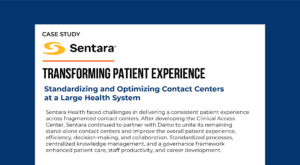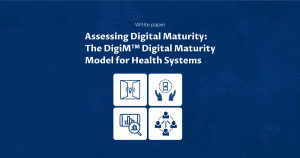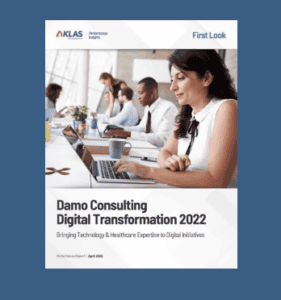Intent of final interoperability rule is to liberate data flow in the industry
– Russ Branzell, CEO of CHIME
Our recent guest on the Big Unlock podcast was Russ Branzell, CEO of CHIME. Russ discusses the role of CHIME in the healthcare industry and how COVID-19 is impacting the industry. He also discussed the final interoperability rule and FCC’s telehealth investment program with Paddy Padmanabhan, CEO of Damo Consulting.
Listen to the full conversation
“CHIME is a professional association for healthcare IT executives. As the industry continues to grow and mature positions, our role is to support our members, both our CHIME members and our CHIME Foundation in their growth to support the industry. We are now in 57 countries around the world. We have eleven independent operating groups or chapters in other countries.” – Russ Branzell, The Big Unlock podcast
Impact of COVID-19 pandemic on CHIME and overall healthcare industry
CHIME has seen some significant growth recently over the last few years. Russ believes that though the current pandemic has impacted them in many ways, there is a positive side to it as well. They are spending more quality time with people and finding ways to support them. Russ also observes that things that were planned for months and years have gotten done in days and weeks.
“The emerging technologies that are already out there that have gone from probably infancy to at least early adulthood in a matter of light-years. We are constrained to home, so we are making a different effort and a different focus than traveling around the globe. We were able to spend some quality time with people, hear what is going on, find out new ways to support them. We are on a digital path that is really to support the entire globe from a digital platform perspective. The biggest change we are seeing is that we have now completely changed to a digital environment that will also complement in-person meetings in the future when things normalize out.” – Russ Branzell
The U.S. model that is very much revenue-based is probably taken the most significant hits due to the current pandemic. There is a significant decrease in outpatient and acute procedures and admissions majorly affecting the bottom line leaving the health systems to make some hard decisions right now. Russ states that organizations who already have their digital strategies in place will move forward effortlessly during the current pandemic.
“The current crisis is going to come in two significant waves. One; short term weathering what they are doing to just make sure they can still meet the mission requirements and then the long-term impact of that as well. Some organizations are going to be well if they have got deep cash on hands and they can weather this out. They have built digital strategies that probably help them somewhat through this, maybe a little more proactively than others. But there is some that this will be a substantial, substantial long-term multi-year hit to recover from. And they will have to figure out how and what they do to invest, to recover from that.” – Russ
Organizations living a world of digital transformation already will flex seamlessly in the current crisis
The entire healthcare ecosystem is going to observe some structural changes in future. In terms of technology, we are already seeing telehealth adoption gone up overnight.
“There are hospitals that are going to merge while others may be closed. There were some reported even last year, they were just closing because of their financial model, their local area was decreasing in population. There’s just that normal process that goes on in any large ecosystem like healthcare. I think this may accelerate it for some as they struggle, or financial issues may happen. It may accelerate for the short term, maybe for the long term. But I think for at least the short term, we may see mergers and acquisitions accelerate, especially with those with the cash ability to help others out.” – Russ
According to Russ, healthcare organizations can be divided in three categories currently; one, organizations who already live a world of digital transformation will move seamlessly right now, as they have their digital strategy in place. Two, some need to figure out how to thrive in this current environment over the next few years. They might struggle a little, but eventually will get help in their journey. Lastly, the third category, organizations that do not have the required infrastructure and support, will find it a difficult journey.
“Organizations who are already living a world of digital transformation will flex and move. They will be able to do that a little more seamlessly, maybe a better way to put that is a little less difficult. Some organizations were able to do it and it was painful. And there are still some organizations really struggling with that. Their digital strategy is its strategy moving forward. Some organizations need to figure out how to really thrive in this environment over the next few years. But it is relatively new for those that were not even on their radar. They’re going to struggle for a little while, but maybe we’ll get help from people like you and others out there that can help them in this journey. But there’s definitely some out there, especially some of our smaller areas that don’t have the infrastructure, the support, telemedicine and the other things where this will be a bit of a journey for them and they may return back to a little bit more of an old school mentality.” – Russ
As per Russ’ discussion with some senior leaders of telemedicine companies, they saw 700 percent increase in their volume due to the current pandemic which went up to a point where they just stopped counting it. However, there is the issue of back-end technology support that they are facing.
“I have been able to talk to some senior leaders, specifically CEOs of some of the telemedicine companies. And it is interesting to hear their numbers when they talk about their entire 2019 volume increase, it was 20 percent. And they were thrilled with that because they beat their budget estimates. In the first week of this, it went up 700 percent and then the next week it went up a thousand percent. And they said at some point we just stopped counting because a straight-up curve is not a curve. It is just a line. And most of them said they are handling it well. The biggest issue that they are seeing is the lack of technology support from the backend technology support.” – Russ
Final Interoperability ruling and FCC’s telehealth investment – what they mean to us in the current scenario
Russ states that the intent of the final interoperability rule is to liberate data flow in the industry. However, in the current crisis when there are fast requirements amidst the COVID fight, how do you balance open accessibility, security, privacy with outright open accessibility flow. Before the organizations adopt to this new change, we need to have strong security and privacy in place.
“ONC’s intent is with the final interoperability rule, I think is to “liberate data flow in the industry”. Now, how do we liberate the data? The intent of the interoperability rule from their perspective and in many cases, we agree with some of their philosophies in this. They want to accelerate the process. I will use another word ‘mandate the process’ to make standard API, standard flows, and standard requirements occur at a fast pace, fast adoption pace. But how do you balance security and privacy with outright open accessibility and flow, and everybody in between have been expressing their concerns or opinions that one area is right, one area is wrong? I think CHIME tries to play in the middle as much both. The reality is everybody is right. We should have strong security and privacy. We should have an open flow. I think as we work through this, what we are going to see is there’s going to be some areas that maybe needs more tweaking like most government rules, and there’ll be some areas that flow fairly easily.”
Talking about the FCC’s telehealth investment plan, Russ states that while it will open new opportunities in rural area it is still relatively a small amount of investment.
“I think that’s good news. But when you start talking about hundreds of millions of dollars, you think while this is going on, this will revolutionize things. Well, it would be if it came to me. But it is still a relatively small amount. I think the hope from this was one, it will fund some of the stuff they’ve been forced to already do, but it will also hopefully open up some opportunity to extend this into some environments where it hasn’t may be seen the maturity that it has rural environments, rural hospitals. This is not new technology. I mean, we had telemedicine to rural clinics. The money will help, but it does not go anywhere near as far as it needs to really get us the maturity we need.” – Russ
The new normal after COVID-19
Russ believes that saying we will ever go back to normal will be incorrect. We will need to consider many things, like the way we will interact to people, how will we work as a society in future. He also believes that the technology impact due to the COVID-19 crisis will accelerate digital activities in health systems.
“I think there are two thoughts that we need to consider right now. I will use the wave theory to express this. The wave one is going to be this COVID thing. It comes up, there is a tail and then we recover and wave two means it is somewhere in the middle, which is pure recovery. We are back to “normal,” I think is incorrect. I think there is at least one, maybe two more curves involved in here in the middle. There probably is a long-term curve of returning to send normal hospital operations functioning the way they should. In terms of technology, I think what we are going to see is that, whether unintended or intended, digital activities will go on. There will be changes in the way we interact with each other.” – Russ














